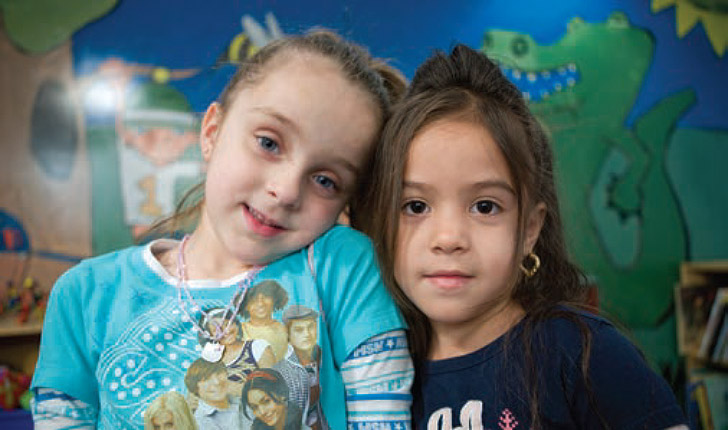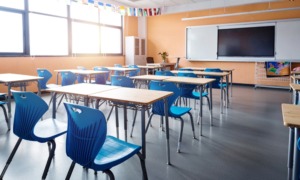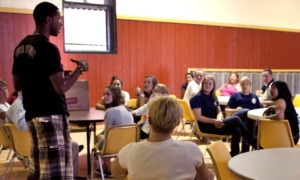
Child homelessness in the United States hit a record high in 2013, afflicting nearly 2.5 million children, or one in 30, according to a report released Monday.
“Child homelessness may result in a permanent Third World in America,” said the 130-page report, “America’s Youngest Outcasts,” released by the National Center on Family Homelessness.
“Without decisive action and the allocation of sufficient resources, the nation will fail to reach the stated federal goal of ending family homelessness by 2020.”
The report notes the federal government has made “concerted efforts” to reduce homelessness among chronically homeless people and military veterans, and these efforts have shown “significant progress.”
But the report cautions that “children and families have not received the same attention — and their numbers are growing.”
The report cites among major causes of child homelessness the nation’s high poverty rate, a lack of affordable housing, continuing impacts of the recession, racial disparities and challenges of single parenting. And traumatic experiences, particularly domestic violence, can precede and prolong homelessness for children and their families, the report said.
Drawing on U.S. Education Department data on homeless schoolchildren and Census Bureau statistics, the report said child homelessness increased 8 percent nationwide from 2012 to 2013 and climbed in 31 states and the District of Columbia. It increased by 10 percent or more in 13 states and in D.C., says the report, which provides a state-by-state breakdown.

Gary Gately
Nationwide, child homelessness has increased sharply from about 1.5 million, or 1 in 50 children, in 2010, the report said.
The effects of child homelessness can be devastating.
“Children experiencing homelessness were more often hungry, sick, and worried where their next meal and bed would come from; they wondered if they would have a roof over their heads at night and what would happen to their families,” the report said. “[Homeless] children often developed more slowly. Many struggled in school, missing days, repeating grades, and even dropping out of school entirely.”
Homeless children also have higher rates of mental illness than other poor children, the report said, and the impacts may even lead to changes in brain architecture that can interfere with learning, managing emotions, cognitive skills and social relationships.
The National Center on Family Homelessness — part of the Washington-based, nonprofit American Institutes for Research — called for additional affordable housing as well as education and job training to help homeless parents so they can obtain employment. The report says parents may also need mental health and other support to deal with untreated trauma and depression and recommends that all services incorporate a “family-oriented, trauma-informed approach.”
The center has been working on the issue for a quarter-century and has two previous reports on child homelessness based on data from 2006 and 2010.
“Children experiencing homelessness are among the most invisible and neglected individuals
in our nation,” the report said. “Despite their ever-growing number, homeless children have no voice and no constituency. Without a bed to call their own, they have lost safety, privacy, and the comforts of home, as well as friends, pets, possessions, reassuring routines, and community. These losses combine to create a life-altering experience that inflicts profound and lasting scars.”
The report counts children who were homeless over the course of a year and includes in its definition of homeless people those lacking a “fixed, regular and adequate nighttime residence,” those with temporary living arrangements, including hotels and motels, as well as those living in homeless shelters.
The U.S. Department of Housing and Urban Development, by contrast, conducts a one-day count of homeless people each year. In its 2013 Annual Homeless Assessment Report, HUD counted 610,042 homeless people, including 130,515 children, during one night in January 2013.
Bruce Lesley, president of the nonprofit, Washington-based First Focus Campaign for Children, called the extent of child homelessness documented in the new report “alarming” and faulted HUD, saying it grossly underestimates homelessness.
“Fixing the problem starts with adopting an honest definition that reflects the reality of today’s homelessness,” Lesley said in an email. “Especially on a problem as serious as child, youth, and family homelessness, Congress and the people who elected them deserve real answers. “
The report ranked states using a composite index based on the extent of child homelessness, efforts to fight it, child well-being and risk for family homelessness.
Alabama received the worst score, followed by Mississippi, California and Arkansas. Minnesota received the highest score, followed by Nebraska, Massachusetts and Iowa.































